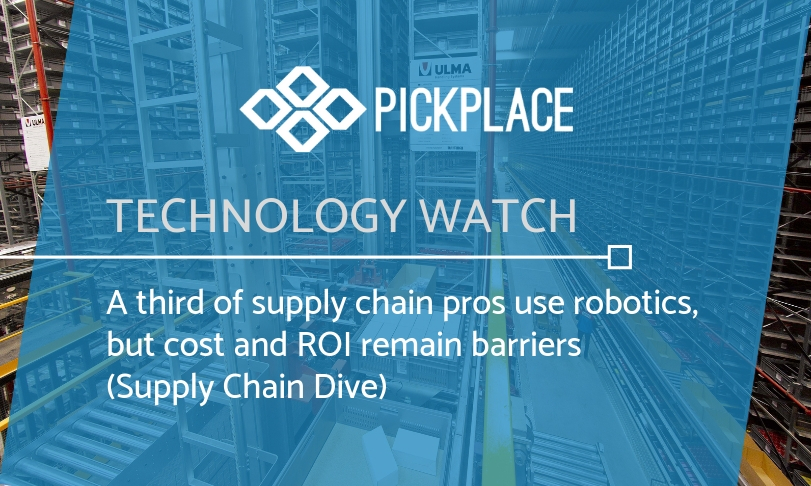Source: Supply Chain Dive / by Matt Leonard

Credit: Yujin Kim / Supply Chain Dive
Dive Brief:
- About 32% of supply chain professionals say they are actively using robotics and automation, according to this year’s MHI Annual Industry Report. This number has gone relatively unchanged since 2016 when 35% of respondents said they were actively using robotics and automation, but anecdotal evidence and market value forecasts show warehouse robotics growing as companies seek labor savings at a time when labor is hard to come by in the logistics industry.
- Other surveys of industry professionals have shown some growth when it comes to the use of warehouse robotics. EFT, a supply chain consultancy, has seen a 7% increase in the number of respondents testing robots in a limited number of warehouse locations, growing from 18.4% in 2018 to 25% in 2019. Another 4% of respondents say they are using robotics in all of their warehouse locations, according to EFT’s 2019 survey. The warehouse robotics market is also expected to grow almost 12% between 2017 and 2022, reaching a value of $4.44 billion by 2022, according to Markets and Markets research.
- One of the biggest challenges to getting warehouse robotics in place remains cost and an unknown return on investment (ROI), according to EFT’s latest survey.

Credit: Matt Leonard / Supply Chain Dive, data from MHI Annual Industry Report
Dive Insight:
The issues surrounding ROI and cost are part of the reason why small- and medium-sized businesses have been slow to adopt robotics, according to Nancey Green Leigh, a Georgia Tech professor who is leading a National Science Foundation-funded project called “Workers, Firms, and Industries in Robotics.”
“In discussions with small firms that have tried to adopt robots, we’ve learned that they feel they are left on their own to figure out how to make them useful in their production systems,” Leigh told Supply Chain Dive. “One firm mentioned resorting to [YouTube] videos to try and get the robot they bought to work.”
One business model robotics companies are considering is robots-as-a-service, which really amounts to companies renting the robots, so they don’t have to invest in the total cost of the hardware upfront, Kary Zate, the director of marketing communications at Locus Robotics, told Supply Chain Dive.
“It also allows them to have the ability of scalability that they never had before,” Zate said. “Simply add more robots whenever they’re needed to take them out when they’re not needed.”
Locus has also considered the training aspect of its technology, so users don’t have to turn to YouTube. Its LocusEmpower solution aids in training and the company claims it will onboard workers “in days, not months.”
Zate said Locus has seen growth in robotics adoption among 3PLs and applications for replenishment fulfillment.
“I think that the side of the business is growing by leaps and bounds,” Zate said. He said medium-sized businesses were starting to show more interest in the technology after seeing successful use cases elsewhere.

Credit: Matt Leonard / Supply Chain Dive, data from EFT
One of the biggest benefits for companies when it comes to robotics is the decreased reliance on labor. The warehouse and logistics industry is struggling to find workers right now. The most recent data from the Bureau of Labor Statistics shows there were 295,000 job openings for warehousing and transportation in May, but only 227,000 of those were actually filled. Robots could be one option for those businesses struggling to find people to do these jobs.
“This is a key reason why we can expect to see an uptake in robot adoption when the makers/suppliers evolve further,” Leigh said after citing this hiring gap.
This is a benefit robotics companies readily highlight. Locus Robotics worked with Forrester Research to study what happened when three businesses started using the Locus product. (Locus paid for the research, but Forrester maintained editorial control over the final report.) The use of robotics at these facilities resulted in a 15% reduction in overtime spending and 25% reduction in errors, reducing overall labor costs, according to the report which was emailed to Supply Chain Dive.
These are benefits many businesses would like to see (though workers and labor advocates might not be as excited). But technology still hasn’t developed to the place where all of the functions inside of a warehouse can be automated. One innovation that will likely spur greater adoption of robotics will be improved picking abilities. Currently, there aren’t any robots that can compete with humans when it comes to picking items and manually moving them to the right place.
“When the picking problem is truly solved, we can expect a lot of lower skilled job loss in warehousing,” Leigh said, adding there will be more high-skilled jobs as e-commerce continues to lead to greater warehouse expansion.

